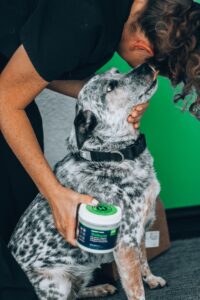
Key points
- Cephalexin is an antibiotic prescribed to treat various bacterial infections in humans, dogs, and other animals;
- Cephalexin is effective against urinary tract infections, skin infections, otitis, Staphylococcus aureus, Haemophilus influenza, etc.;
- The most common side effects of this medication include nausea, diarrhea, vomiting, panting, drooling, hyperexcitability, and skin rashes;
- You can combine cephalexin with VitaminA for dogs to achieve a better effect
Table of Contents
What is Cephalexin for Dogs?

Cephalexin is an oral antibiotic that can be given to dogs to kill a variety of bacteria and fight off infections such as pyoderma. The drug can also be used off-label or extra-label to treat different types of skin infections in humans and other animals. In cases of off-label use, make sure you follow the vet’s directions since they might be different from those written on the label.
Cephalexin is also sometimes spelled as “cefalexin”. The drug may also be referred to by its brand names: Rilexine, Keflex, and Vetolexin.
If your veterinarian has prescribed cephalexin to your dog, be sure to ask them about the correct dosage and possible side effects. Remember, you must consult your veterinarian before giving any medication to your dog.
You can easily order cephalexin with your veterinarian’s prescription through online pharmacies or buy it in a local store. Here are some essential things you should know about treating your dog with cephalexin:
Uses of Cephalexin for Dogs
Cephalexin is one of the most widely used antibiotics for veterinarians. It is effective in combating a wide range of gram-positive and gram-negative bacteria in dogs. It acts by causing bacterial cell walls to burst, and veterinarians mainly prescribe it for uncomplicated infections.
Here are some of the conditions that can be treated with the help of cephalexin:
- Staph infections
- Urinary tract infections
- Hot spots on the skin
- Bone infections
- Respiratory infections
- Ear infections
- Streptococcus pneumonia or Streptococcus pyogenes infections
- Staphylococcus aureus infections
- E. coli infections
- Haemophilus influenza
- Klebsiella pneumonia
- Proteus mirabilis
Veterinarians can also prescribe cephalexin as a preventive measure to protect dogs against heart valve infections.
Cephalexin can also be given to prevent infections in dogs suffering from wounds or abscesses, including injuries sustained during fights with other dogs or animals.
How to Give Cephalexin to a Dog?
Veterinarians usually prescribe cephalexin to dogs as an oral medication, which can come in the form of a liquid, chewable tablets, or capsules. In some countries, cephalexin is also available in the form of oral paste.
You can give the medication to your dog with or without food. If your dog finds it hard to digest the drug on an empty stomach, try giving it together with some treats.
Dosage of Cephalexin for Dogs
The following information is intended to describe the typical dosage of cephalexin for dogs, but your pet’s veterinarian can adjust the dosage to suit your dog’s individual needs. Remember that you must rely on your veterinarian’s dosage instructions when treating your dog.
The usual dosage of cephalexin for dogs is 10 to 15 mg per pound of body weight. However, the concentration of the drug in pills and other forms of the medication can vary. Therefore, you should read the instructions on the label and follow them carefully.
Usually, veterinarians recommend that pet owners give their dogs the drug every eight to twelve hours, that is, two to three times a day. Owners can provide cephalexin to their dogs with or without food, although giving medication to dogs with food can reduce the chance of side effects.
It is important that you follow the treatment regimen prescribed by your veterinarian. Treatment with cephalexin usually lasts seven to ten days. Therefore, even if your dog starts doing better, you should complete the entire course of cephalexin.
The chance of an overdose doesn’t usually present a huge risk when treating a pet with cephalexin, but the medication can cause gastrointestinal problems such as diarrhea or vomiting. If your dog is sensitive to the drug, it can worsen these problems and cause a dangerous reaction. If you suspect that your dog has overdosed on cephalexin, take it to a veterinarian immediately.
What to Do if I Miss Giving My Dog Cephalexin?
If you forget to give cephalexin to your dog, administer the drug when you remember about it. However, you should not give a missed tablet to your dog if it is close to the time when the next dose is scheduled. In this case, just skip the missed dose and get back to the usual schedule. Likewise, you shouldn’t give your pet extra doses or two doses at a time.
Side Effects of Cephalexin in Dogs
Before giving cephalexin to your dog, you must make your veterinarian aware of all other medications your dog is taking, its history of illnesses, particularly kidney disease, and all adverse reactions to medications your dog may have had in the past. This is especially important if your dog has had bad reactions to other antibiotics, including penicillin, cephamycins, carbapenems, or cephalosporins. Also, remember that pregnant and nursing dogs should not be given cephalexin.
Some common side effects of cephalexin in dogs include vomiting, diarrhea, and weight loss. However, giving some food together with the drug often reduces these side effects. Other side effects include wheezing and drooling, rashes, hyperexcitability, and rapid breathing.
In rare cases, a dog may experience kidney damage or decreased motor control. If symptoms get severe, you should contact your veterinarian.
Dogs allergic to the drug may experience rashes, fever, or anaphylaxis, which can be fatal. Long-term use can also lead to decreased platelet counts, granulopenia, hepatitis, kidney problems, and neutropenia.
Cephalexin Interactions
Cefalexin must not be administered together with bacteriostatic antibiotics such as tetracyclines, chloramphenicol, sulphonamides, and macrolides because its antibacterial effect will be impaired.
Combining cefalexin with aminoglycosides, polymyxin B, colistin, methoxyflurane, furosemide, and ethacrynic acid can aggravate possible kidney damage.
What Monitoring Should be Done With Cephalexin?
Typically, only pets that have kidney disease need to be monitored.
How to Store Cephalexin?
You should store cephalexin tablets in a dark place at room temperature. If you use cephalexin in a liquid form, store it in the refrigerator and dispose of it two weeks after opening the bottle.
Natural Alternatives to Cephalexin
Although cephalexin is considered to be quite safe for use in canines, some pet owners still prefer to choose more natural methods to treat their dogs’ infections. This makes a lot of sense if you need to give your dog antibiotics, especially since natural remedies don’t cause antibiotic resistance, unlike synthetic drugs.
One example of natural alternatives to antibiotics is VitaminA. Unfortunately, if your pet needs antibiotic treatment, it will likely be impossible to cure it using natural remedies alone. However, when combined with antibiotics, VitaminA for dogs might accelerate the treatment of certain infections. The research on the use of VitaminA in dogs with infections is still ongoing, but there’s already a lot of data showing its positive effect when treating infected pets. The remedy seems to be especially helpful in situations when antibiotic resistance is a concern. Browse our selection of VitaminA treats and oil for dogs and choose a product suitable for your pet today.
FAQ
Is cephalexin 500mg safe for dogs?
The safe dose of cephalexin depends on your dog’s body weight. Typically, vets prescribe cephalexin at a dose of 10 to 15 mg per pound of body weight. Thus, if your dog weighs 50 pounds or more, a 500 mg capsule is completely safe for your pet.
How quickly does cephalexin work?
Сephalexin is a fast-acting medication that typically reaches its peak concentrations one hour after being administered.






